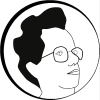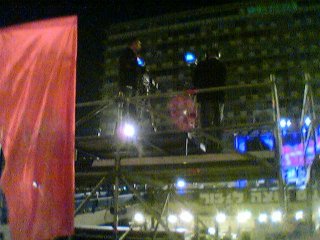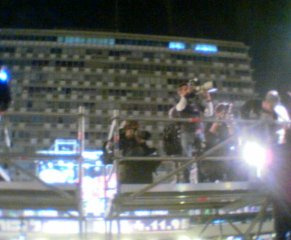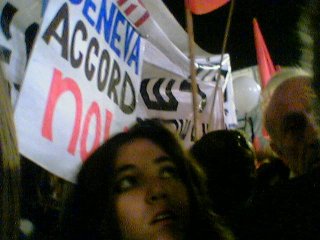
Accessibility of Itzhak Rabin's Memorial Event at Nov. 12th, 2005On Saturday night Nov. 12th, 2005, I was in Rabin Square, Tel Aviv and attended the memorial event, which was held ten years after Itzhak Rabin's murder at the same place. About the event itself including the music and speeches - especially the speech by Bill Clinton, the USA President during Itzhak Rabin's 2nd reign as Prime Minister - other and better people than me wrote. In view of my experience with the poor accessibility to the deaf of Rabin's funeral broadcast ten years ago, I decided to see and report on the current accessibility situation. The initiative to make the memorial event accessible to the hearing impaired did not come from Itzhak Rabin Institute, the organizers of the event. The initiative came from Lee Dan, a Sign Language interpreter. It was evident that she got good cooperation from the organizers. When I came to Rabin Square, it was already crowded. However, the crowd was not tightly packed and it was relatively easy for me to reach the fence separating the crowd from the stage. 
There were two raised platforms between the fence and the stage. They partially obstructed the stage but I preferred to stand there because the Sign Language interpreter stood on the right raised platform. She was illuminated by a lamp. I found the illumination to be adequate for the job, but it could be made more diffuse. The left platform hosted two TV cameras, with a cameraman behind each one. 
To serve people, who stood far from the stage, the organizers provided a large screen. On this screen, the TV broadcast from the event was projected. Faces of the speakers could be seen by the far crowd at the same time the TV viewers could see them at home. 
The crowd came to the event well-equipped with banners, balloons and placards as befitting a demonstration. The placards obstructed the stage and the interpreters for people, who were not near the fence. However, at beginning of the event, the organizers asked the crowd to lower their banners so that people behind them will be able to see the stage and the interpreter. Most of the audience complied with the request. During the event itself, the interpreter rendered the speeches and the songs. Since Lee Dan can interpret from both Hebrew and English into Israeli Sign Language and vice versa, we could follow also Bill Clinton's speech, even though it was delivered in English. During the event, photographers climbed on the right platform and sometimes it was rather crowded, as can be seen from the photo. However, they usually respected the space around the interpreter. The TV broadcast included subtitles for the songs, which were being sung by the various singers in the event. However, the speeches were not subtitled. One more point to be noted was the crowd's attitude toward accessibility for deaf people. Overall, the attitude was positive. Most of the people moved aside or let us pass through or suggested better positions for us once they knew that we are deaf. One man clinged to the fence, but I stood at his behind and could follow the interpreter as easily as if I stood in his place. Summary of accessibility of the event:
Conclusions for the future:
Last update date: 2005 Nov 14 |
DonationDid this Web site help you? If yes, you may want to consider making a donation to me. When making a donation, please tell me what additional information could I add to the Web site, to make it even more helpful for you and people like you. |